Abstract
Previous studies of the mechanisms that precipitate acid reflux episodes have used short term hospital based measurements. A 24 hour pH and motility recording system, incorporating a sphincter monitoring device, has been developed to study naturally occurring acid reflux episodes in control subjects and patient groups with different grades of oesophagitis. Lower oesophageal sphincter relaxations related to episodes of acid reflux were common in control subjects (67% of episodes) but became more difficult to detect as the grade of oesophagitis increased (grade 0/1 - 67%, grade 2/3 - 35%, grade 4 - 13%). A variety of events that produced recognisable transdiaphragmatic pressure patterns were associated with acid reflux episodes. In control subjects 74% of acid reflux episodes were precipitated by belching but this mechanism became less evident as the grade of oesophagitis increased (grade 0/1 - 43%, grade 2/3 - 40%, grade 4 - 29%). Activities that produced a pressure gradient across the diaphragm became increasingly important as events precipitating acid reflux as oesophagitis became more severe (controls--2%, grade 0/1 - 15%, grade 2/3 - 11%, grade 4 - 22%). This study has shown the pressure events surrounding acid reflux in fully ambulant patients with gastro-oesophageal reflux disease.
Full text
PDF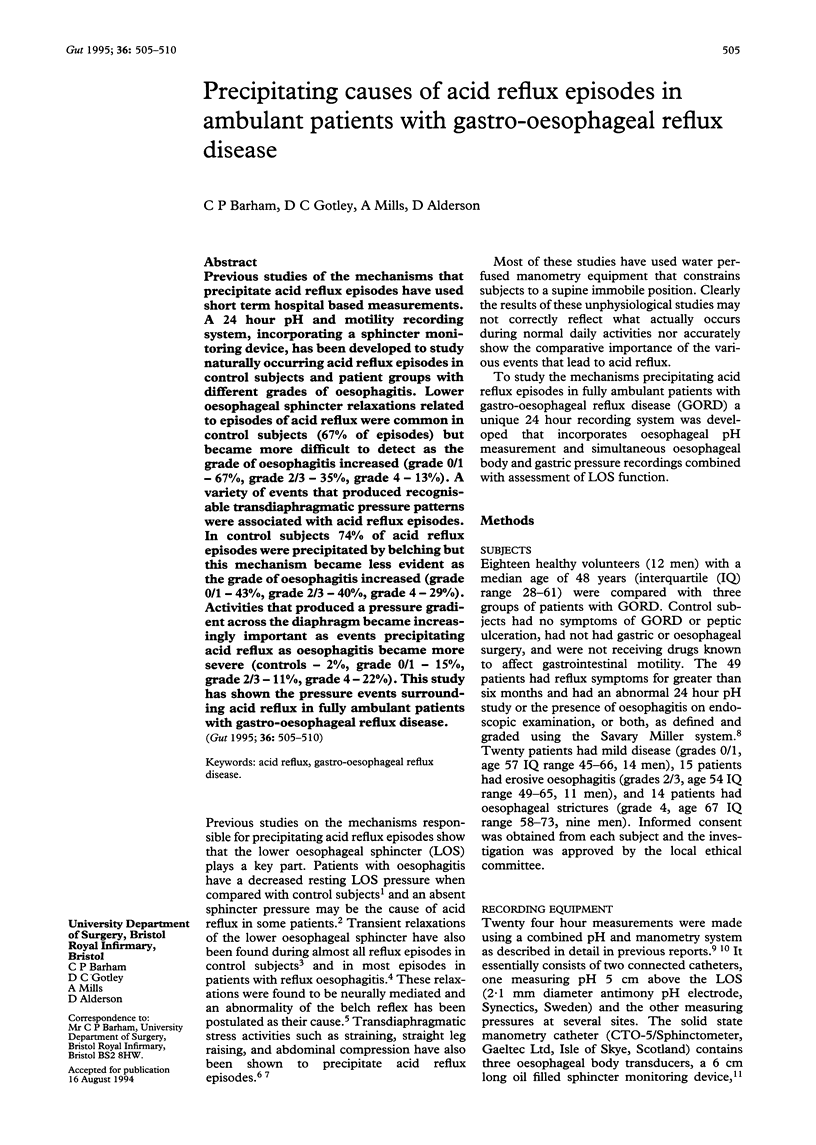
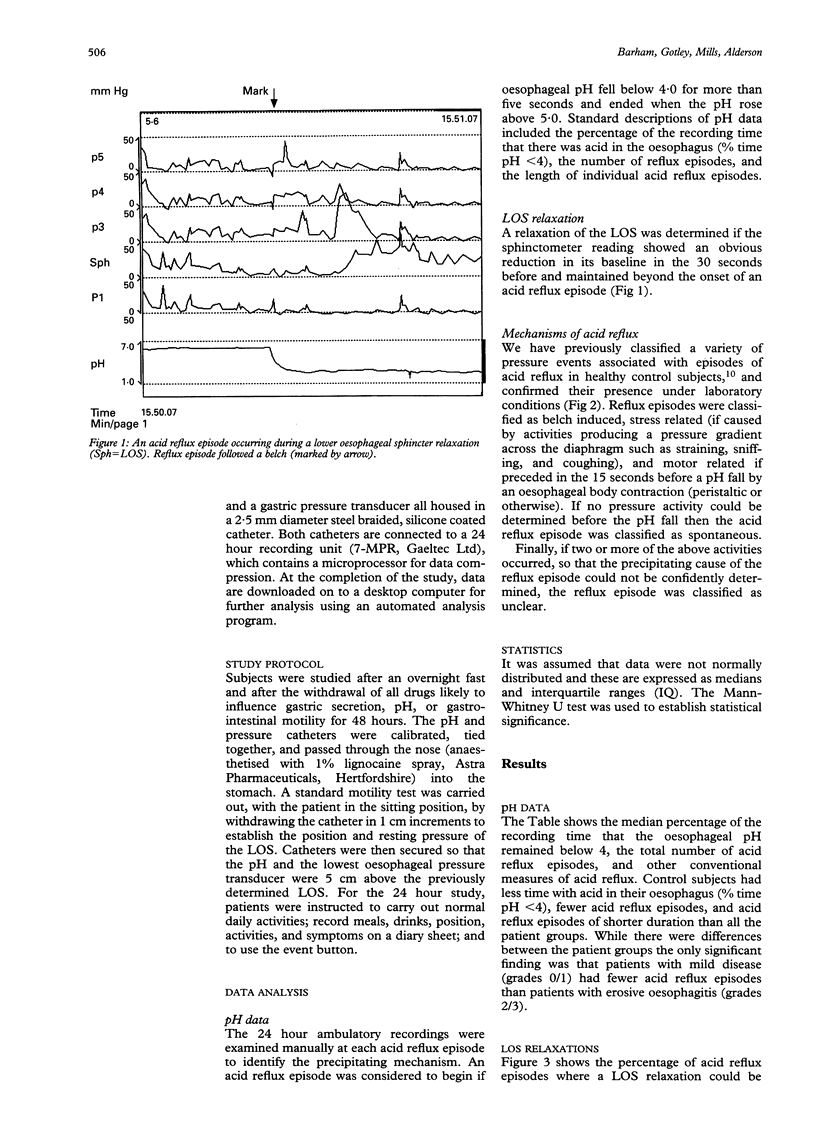
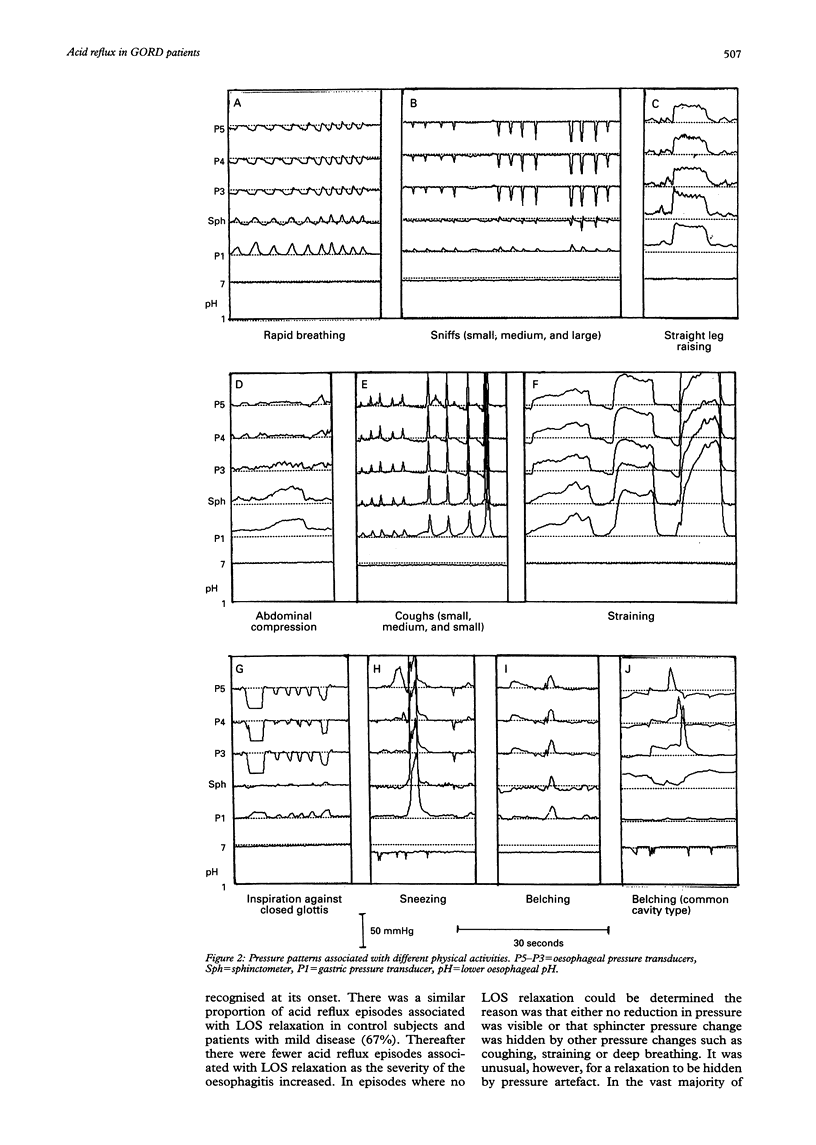
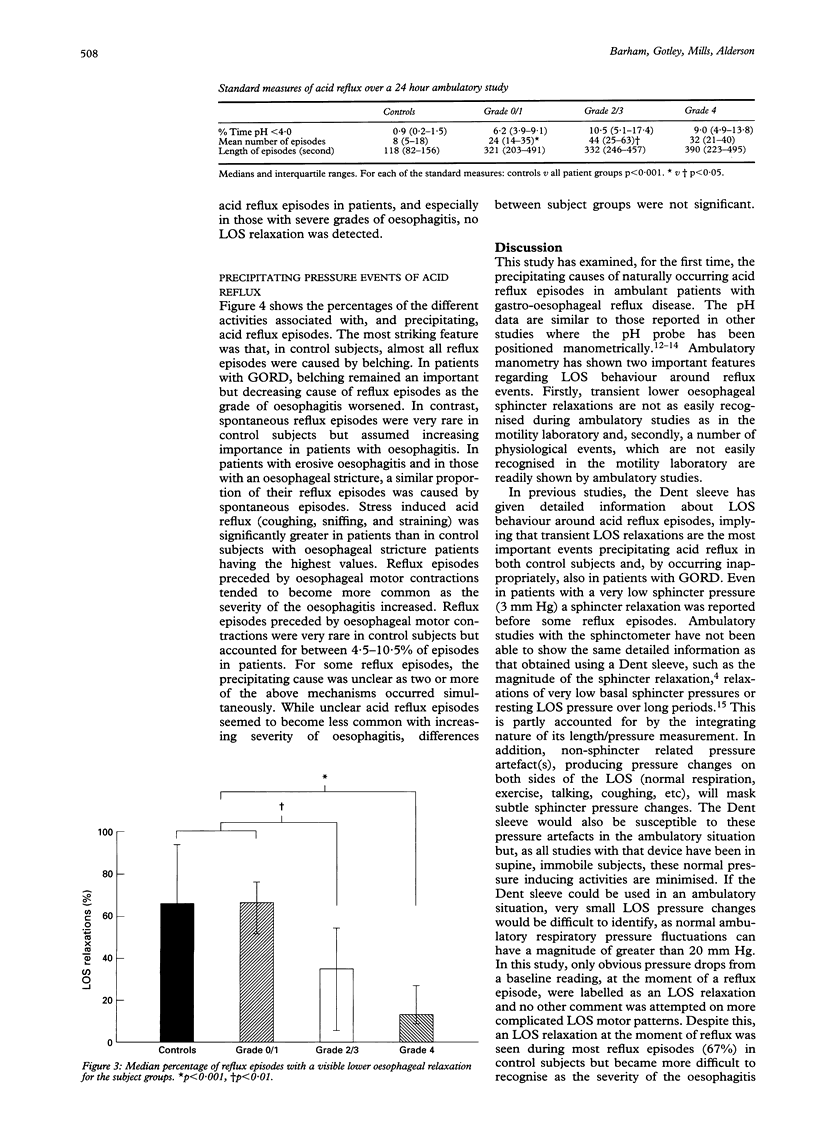
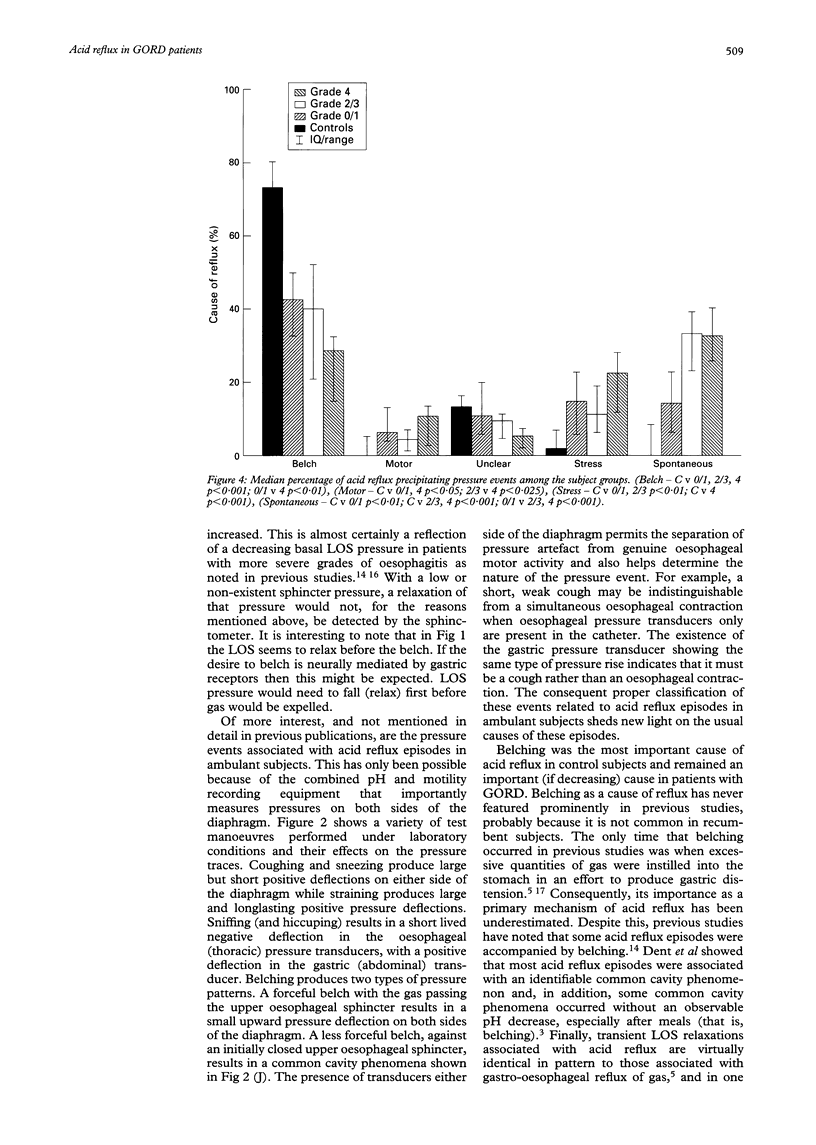
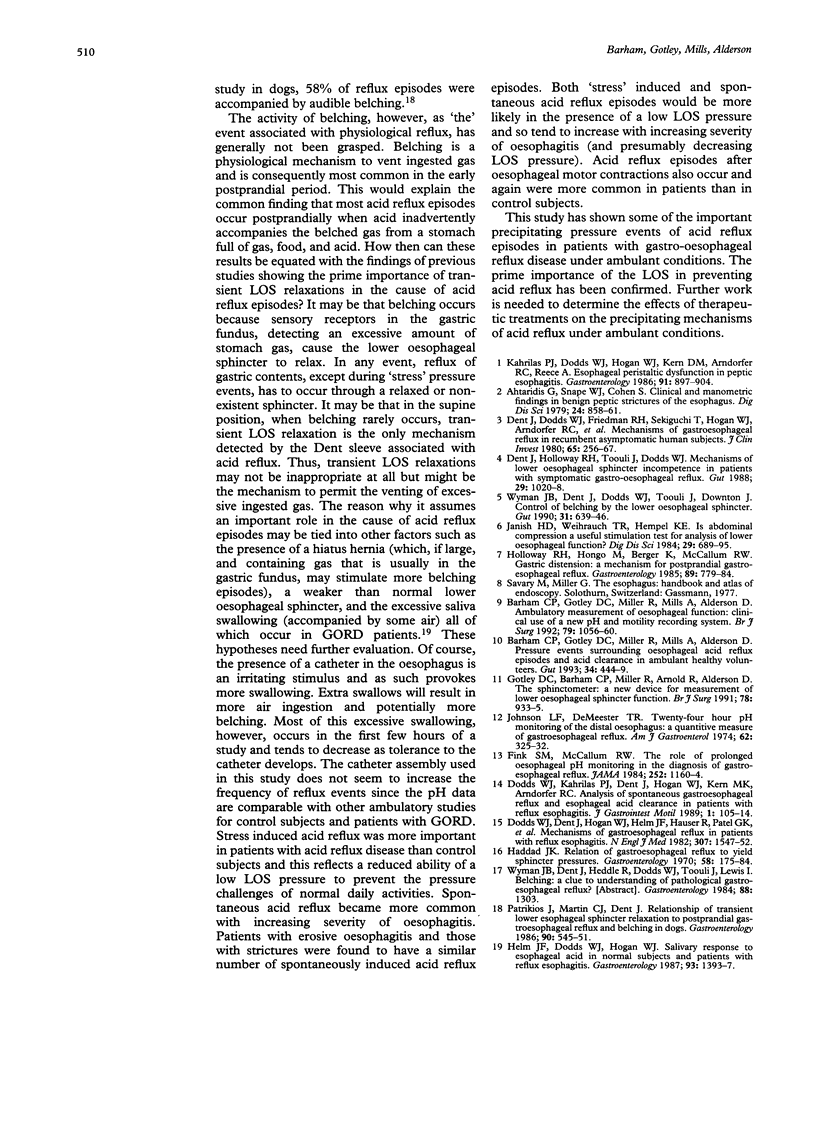
Selected References
These references are in PubMed. This may not be the complete list of references from this article.
- Ahtaridis G., Snape W. J., Jr, Cohen S. Clinical and manometric findings in benign peptic strictures of the esophagus. Dig Dis Sci. 1979 Nov;24(11):858–861. doi: 10.1007/BF01324902. [DOI] [PubMed] [Google Scholar]
- Barham C. P., Gotley D. C., Miller R., Mills A., Alderson D. Ambulatory measurement of oesophageal function: clinical use of a new pH and motility recording system. Br J Surg. 1992 Oct;79(10):1056–1060. doi: 10.1002/bjs.1800791023. [DOI] [PubMed] [Google Scholar]
- Barham C. P., Gotley D. C., Miller R., Mills A., Alderson D. Pressure events surrounding oesophageal acid reflux episodes and acid clearance in ambulant healthy volunteers. Gut. 1993 Apr;34(4):444–449. doi: 10.1136/gut.34.4.444. [DOI] [PMC free article] [PubMed] [Google Scholar]
- Dent J., Dodds W. J., Friedman R. H., Sekiguchi T., Hogan W. J., Arndorfer R. C., Petrie D. J. Mechanism of gastroesophageal reflux in recumbent asymptomatic human subjects. J Clin Invest. 1980 Feb;65(2):256–267. doi: 10.1172/JCI109667. [DOI] [PMC free article] [PubMed] [Google Scholar]
- Dent J., Holloway R. H., Toouli J., Dodds W. J. Mechanisms of lower oesophageal sphincter incompetence in patients with symptomatic gastrooesophageal reflux. Gut. 1988 Aug;29(8):1020–1028. doi: 10.1136/gut.29.8.1020. [DOI] [PMC free article] [PubMed] [Google Scholar]
- Dodds W. J., Dent J., Hogan W. J., Helm J. F., Hauser R., Patel G. K., Egide M. S. Mechanisms of gastroesophageal reflux in patients with reflux esophagitis. N Engl J Med. 1982 Dec 16;307(25):1547–1552. doi: 10.1056/NEJM198212163072503. [DOI] [PubMed] [Google Scholar]
- Fink S. M., McCallum R. W. The role of prolonged esophageal pH monitoring in the diagnosis of gastroesophageal reflux. JAMA. 1984 Sep 7;252(9):1160–1164. [PubMed] [Google Scholar]
- Gotley D. C., Barham C. P., Miller R., Arnold R., Alderson D. The sphinctometer: a new device for measurement of lower oesophageal sphincter function. Br J Surg. 1991 Aug;78(8):933–935. doi: 10.1002/bjs.1800780812. [DOI] [PubMed] [Google Scholar]
- Haddad J. K. Relation of gastroesophageal reflux to yield sphincter pressures. Gastroenterology. 1970 Feb;58(2):175–184. [PubMed] [Google Scholar]
- Helm J. F., Dodds W. J., Hogan W. J. Salivary response to esophageal acid in normal subjects and patients with reflux esophagitis. Gastroenterology. 1987 Dec;93(6):1393–1397. doi: 10.1016/0016-5085(87)90270-8. [DOI] [PubMed] [Google Scholar]
- Holloway R. H., Hongo M., Berger K., McCallum R. W. Gastric distention: a mechanism for postprandial gastroesophageal reflux. Gastroenterology. 1985 Oct;89(4):779–784. doi: 10.1016/0016-5085(85)90572-4. [DOI] [PubMed] [Google Scholar]
- Janisch H. D., Weihrauch T. R., Hampel K. E. Is abdominal compression a useful stimulation test for analysis of lower esophageal sphincter function? Dig Dis Sci. 1984 Aug;29(8):689–695. doi: 10.1007/BF01312939. [DOI] [PubMed] [Google Scholar]
- Johnson L. F., Demeester T. R. Twenty-four-hour pH monitoring of the distal esophagus. A quantitative measure of gastroesophageal reflux. Am J Gastroenterol. 1974 Oct;62(4):325–332. [PubMed] [Google Scholar]
- Kahrilas P. J., Dodds W. J., Hogan W. J., Kern M., Arndorfer R. C., Reece A. Esophageal peristaltic dysfunction in peptic esophagitis. Gastroenterology. 1986 Oct;91(4):897–904. doi: 10.1016/0016-5085(86)90692-x. [DOI] [PubMed] [Google Scholar]
- Patrikios J., Martin C. J., Dent J. Relationship of transient lower esophageal sphincter relaxation to postprandial gastroesophageal reflux and belching in dogs. Gastroenterology. 1986 Mar;90(3):545–551. doi: 10.1016/0016-5085(86)91107-8. [DOI] [PubMed] [Google Scholar]
- Wyman J. B., Dent J., Heddle R., Dodds W. J., Toouli J., Downton J. Control of belching by the lower oesophageal sphincter. Gut. 1990 Jun;31(6):639–646. doi: 10.1136/gut.31.6.639. [DOI] [PMC free article] [PubMed] [Google Scholar]


